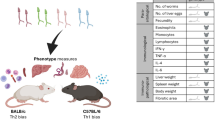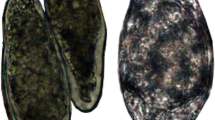Abstract
In mixed infections ofSchistosoma haematobium andS. mattheei, homospecific and heterospecific pairs are formed, with a preponderance of homospecific pairs indicating the existence of a mate preference system.S. haematobium apparently exhibits a greater specific mate recognition system than doesS. mattheei. In sequential infections when mice are exposed toS. mattheei 4 weeks after infection withS. haematobium, S. haematobium males are better at pairing withS. mattheei females than areS. mattheei males. Hence, genetic exchanges betweenS. haematobium andS. mattheei giving rise to viable hybrids poses the problem of the genetic identity of these species of schistosomes. The most important reproductive isolating mechanisms are definitive host specificity,S. haematobium being primarily a parasite of man, whereasS. mattheei is a parasite of domestic stock and wild ungulates, and the preference for homo-specific pairings in simultaneous infections. In contrast, whenS. haematobium is the older infection,S. haematobium males are better thanS. mattheei males at pairing with females of either species. Hybridisation is the likely outcome of such interactions. The lack of viability ofS. mattheei male XS. haematobium female indicates genetic differences between the two species. Occurrences of natural hybridisation betweenS. haematobium andS. mattheei may lead to a change in the response of the parasite to chemotherapeutic treatment.
Similar content being viewed by others
References
Alves W (1947) Observations onS. mattheei andS. haematobium. Adults and eggs from experimental animals and man. Trans R Soc Trop Med Hyg 41:430–431
Jourdane J, Southgate VR (1992) Genetic exchanges and sexual interactions between species of the genusSchistosoma. Res Rev Parasitol 52:21–26
Kruger FJ (1990) Frequency and possible consequences of hybridization betweenSchistosoma haematobium andS. mattheei in the Eastern Transvaal Lowveld. J Helminthol 64:333–336
Kruger FJ, Evans AC (1990) Do all human urinary infections withSchistosoma mattheei represent hybridization betweenS. haematobium andS. mattheei? J Helminthol 64:330–332
Kruger FJ, Hamilton-Atwell (1988) Scanning electron microscope studies of miracidia suggest introgressive hybridization betweenSchistosoma haematobium andS. haematobium XS. mattheei in the Eastern Transvaal. J Helminthol 62:141–147
Kruger FJ, Schutte CHJ, Visser PS, Evans AC (1986a) Phenotypic differences inSchistosoma mattheei ova from populations sympatric and allopatric toS. haematobium. Onderstepoort J Vet Res 53:103–107
Kruger FJ, Hamilton-Attwell VL, Schutte CHJ (1986b) Scanning electron microscopy of the teguments of males from five populations ofSchistosoma mattheei. Onderstepoort J Vet Res 53: 108–110
Le Roux PL (1954)Schistosoma spp. recovered experimentally through snails, mice and hamsters from a human subject of urinary schistosomiasis. Trans R Soc Trop Med Hyg 48:281
Pitchford RJ (1959) Cattle schistosomiasis in man in the eastern Transvaal. Trans R Soc Trop Med Hyg 53:285–290
Pitchford RJ (1961) Observations on a possible hybrid between the two schistosomesS. haematobium andS. mattheei. Trans R Soc Trop Med Hyg 55:44–51
Pitchford RJ, Lewis M (1978) Oxamniquine in the treatment of various schistosome infections in South Africa. S Afr Med J 53:677–680
Rollinson D, Southgate VR (1987) The genusSchistosoma: a taxonomic appraisal. In: Rollinson D, Simpson AJG (eds) The biology of schistosomes: from genes to latrines. Academic Press London, pp 1–49
Schutte CHJ (1983) Die Epidemiologie van Bilharzia in die Republiek van Suid-Afrika. S Afr J Contin Med Ed 1:45–49
Southgate VR, Rollinson D, Ross GC, Knowles RJ (1982) Mating behaviour in mixed infections ofSchistosoma haematobium andS. intercalatum. J Nat Hist 16:491–496
Taylor MG (1970) Hybridisation experiments on five species of African schistosomes. J Helminthol 44:253–314
Tchuem Tchuenté LA, Imbert-Establet D, Delay B, Jourdane J (1993) Choice of mate, a reproductive isolating mechanism betweenSchistosoma intercalatum andS. mansoni in mixed infections. Int J Parasitol 23:179–185
Tchuem Tchuenté LA, Southgate VR, Imbert-Establet D, Jourdane J (1995) Change of mate and mating competition between males ofSchistosoma intercalatum andS. mansoni. Parasitology 110:45–52
Van Wyk JA (1977) Transmission ofSchistosoma mattheei from animals to man. In: Gear JHS (ed) Medicine in a tropical environment: proceedings of international symposium held in South Africa, 1976. A.A. Balkema, Cape Town, pp 705–717
Wright CA, Ross GC (1980) Hybrids betweenSchistosoma haematobium andS. mattheei and their identification by isoelectric focusing of enzymes. Trans R Soc Trop Med Hyg 74: 326–332
Wright CA, Southgate VR (1976) Hybridization of schistosomes and some of its implications. In: Taylor AER, Muller R (eds) Genetic aspects of host-parasite relationships. Blackwell Scientific Publications, Oxford, pp 55–86
Wright CA, Southgate VR, Ross GC, Knowles RJ (1977) Strain characterization inSchistosoma. Trans R Soc Trop Med Hyg 71:287
Author information
Authors and Affiliations
Corresponding author
Rights and permissions
About this article
Cite this article
Southgate, V.R., Tchuem Tchuenté, L.A., Vercruysse, J. et al. Mating behaviour in mixed infections ofSchistosoma haematobium andS. mattheei . Parasitol Res 81, 651–656 (1995). https://doi.org/10.1007/BF00931841
Received:
Accepted:
Issue Date:
DOI: https://doi.org/10.1007/BF00931841




